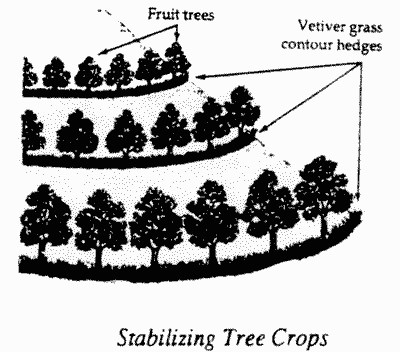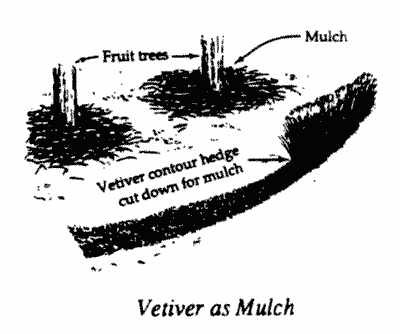
ABOUT VETIVER GRASS - THE HEDGE AGAINST EROSION
SCIENTIFIC NAME: Chrysopogon zizanioides
FAMILY: FAMILY: Poaceae
Why vetiver grass is the ideal plant for the Vegetative System of Soil and Moisture Conservation: Although many grasses and trees have been tried over the years as measures to prevent erosion, to date only vetiver grass has stood the test of time.
As made clear by the following list of its characteristics derived from observations of Vetiveria zizanioides throughout the world, this truly remarkable plant is ideally suited for the vegetative system of soil and moisture conservation. No other grass is known to rival its hardiness or diversity.
• When planted correctly, V. zizanioides will quickly form a dense, permanent hedge.
• It has a strong fibrous root system that penetrates and binds the soil to a depth of up to 3 metres and can withstand the effects of tunnelling and cracking.
• It is perennial and requires minimal maintenance.
• It is practically sterile, and because it produces no stolons or rhizomes, it will not become a weed.
• Its crown is below the surface, which protects the plant against fire and overgrazing.
• Its sharp leaves and aromatic roots repel rodents, snakes, and similar pests.
• Its leaves and roots have demonstrated a resistance to most diseases.
• Once established, it is generally unpalatable to livestock. The young leaves, however, are palatable and can be used for fodder. (In Karnataka, India, a cultivar of V. zizanioides selected by farmers has softer leaves and is more palatable to livestock. This cultivar is also more dense, less woody, and more resistant to drought than some of the other available cultivars.)
• It is both a xerophyte and a hydrophyte, and once established, it can withstand drought, flood, and long periods of waterlogging.
• It will not compete with the crop plants it is used to protect. Vetiver grass hedges have been shown to have no negative effect on - and may, in fact, boost the yield of neighbouring food crops.
• It is suspected to have associated nitrogen-fixing mycorrhiza, which would explain its green growth throughout the year.
• It is cheap and easy to establish as a hedge and to maintain, as well as to remove, if it is no longer wanted.
• It will grow in all types of soil, regardless of fertility, pH, or salinity. This includes sands, shales, gravels, and even soils with aluminium toxicity.
• It will grow in a wide range of climates. It is known to grow in areas with average annual rainfall between 200 and 6,000 mm and with temperatures ranging from 9° to 45°C.
• It is a climax plant, and therefore even when all surrounding plants have been destroyed by drought, flood, pests, disease, fire or other adversity, the vetiver will remain to protect the ground from the onslaught of the next rains.
GROWING TREE CROPS ON HILLSIDES
Vetiver's stabilizing influence is especially useful in steep and rolling country, where the distribution of moisture cannot be controlled. Unsuitable for the cultivation of cereal or other annual crops, such areas can be successfully planted to perennial tree crops on the contour when stabilized by vetiver grass.

Most attempts to grow tree crops on steep hillsides are abandoned because the resulting poor, uneven stands are not worth the cost of maintenance. The figures show a method of establishing tree crops on such hills using contour vetiver hedges.
First the contours of the hill are pegged out. Next, by hand or with a bulldozer and ripper unit, the farmer digs shallow V ditches along the contour lines. A row of trees is planted close to the edge of each ditch, and vetiver grass is planted in the ditches.
Under this arrangement of planting, the runoff between one row of trees and the next one down the slope collects in the vetiver-lined ditches. (There is usually sufficient drainage on the slopes to preclude the possibility of waterlogging). Thanks to the effects of such water harvesting, the rows of trees do not have to be planted as close together as the trees within a row. Initially, the V ditch will provide a measure of runoff control, thereby increasing the soil's moisture content, and both the vetiver and the planted trees will benefit.
By the time the ditch 'melts away' after a couple of years, the vetiver hedge will be established and performing its function of increasing the infiltration of runoff, halting the loss of soil and soil nutrients, and creating a natural terrace.

Because the collection of runoff in the contour ditches has the effect of doubling or tripling the amount of effective rainfall, fruit trees planted by this method need no irrigation in the first three years of establishment. The whole system is stabilized by the vetiver grass lines.
After the vetiver hedges have properly established, the vetiver grass can be cut down to ground level when the dry season sets in and its leaves used as a mulch at the base of the fruit trees to help retain stored moisture.
The advantage of using vetiver for this purpose is that its leaves harbor few insects and last well as a mulch. Vetiver hedges also protect the young trees in the hot summer months by providing some indirect shade, and in the colder winter months by acting as windbreaks.
Forest trees should be planted by the same method. Where this has been done, the results have been spectacular: more than 90% of the seedlings so planted survived the 1987 drought in Andhra Pradesh, India, whereas 70% of the other seedlings died.
DATE: July 1991
* * * * * * * * * * * * *
